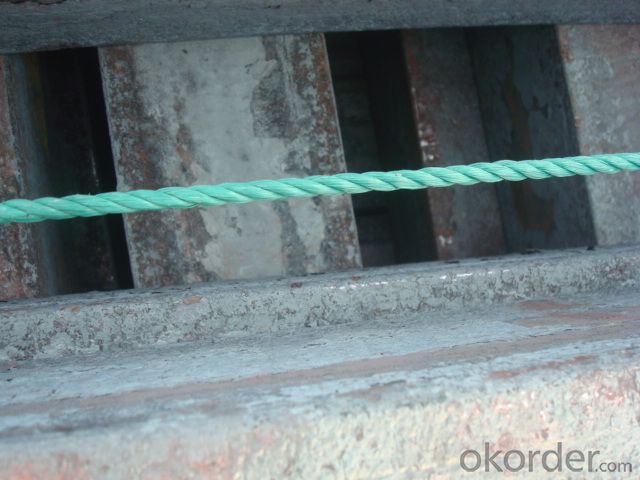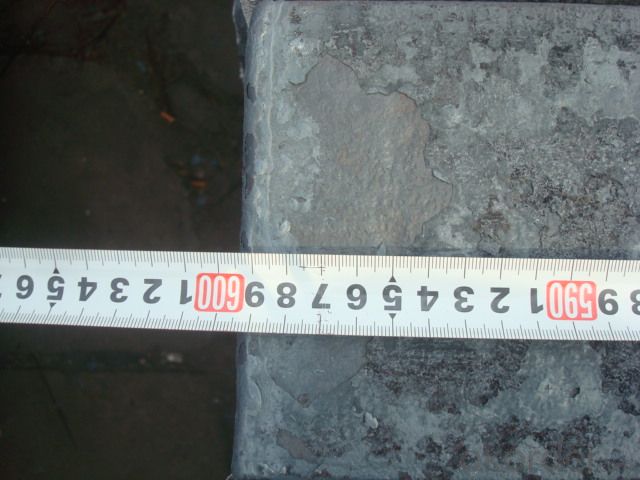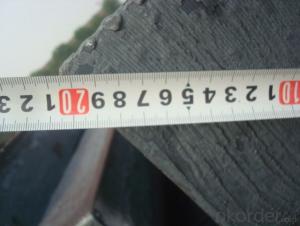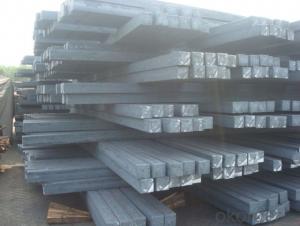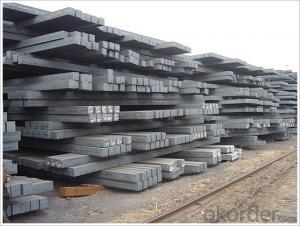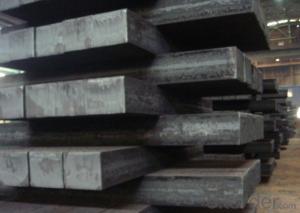Steel Billet Hot Rolled in Amazing Price
- Loading Port:
- Tianjin
- Payment Terms:
- TT OR LC
- Min Order Qty:
- 1000 m.t.
- Supply Capability:
- 50000 m.t./month
OKorder Service Pledge
OKorder Financial Service
You Might Also Like
1.Structure of Steel Billet
Steel billet(ingot) by cogging or breakdown of semi-finished products, is the raw material of all kinds of steel mill. Billet section of square, round, flat, rectangular and abnormity of several kinds of, mainly related to the shape of rolled products.
2.Main Features of Steel Billet
Rectangular billet continuous casting billet and mainly general carbon steel, low carbon low silicon cold-rolled material, high quality carbon structural steel, high strength low alloy steel, special steel, etc.
The billet is mainly divided into two kinds from the shape:
Slab: cross section width and height of the ratio of the larger, mainly used for rolling plate.
Billet: equal cross section width and height, or a huge difference, mainly used for rolling steel, wire rod. ,
Steel billets have distinct characteristics as compared with already furnished steel bars and products. Billets have a specific grain structure, which enables the metal to be processed more intricately. Steel billets are also known for their malleability and ductility, especially when exposed to varying temperatures during shaping and molding.
3.Steel Billet Images
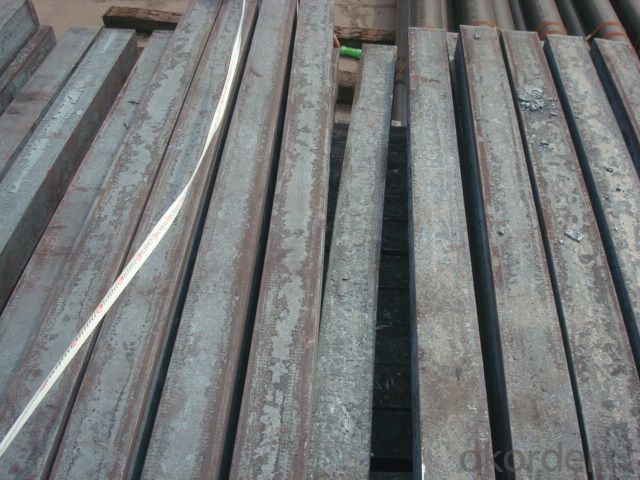

4. Steel Billet Specification
Hot rolled billet steel
Size: 50x50mm-180x180mm
Steel Grade: 3SP, 5SP,Q195,Q235,Q255,Q275 Length:3m-12m
MOQ: 1000MT/size
Payment term: TT or LC
Packing: in bulk , bundle
Shipment: by container , bulk vessel
Packaging Details: bundles with steel strips or as customers's requirements
Delivery time: 15-30 days after the deposit
Loading port:Tianjin, or other port China
Origin :China
Inspection:Third party inspection before loading.
5.FAQ
We have organized several common questions for our clients,may help you sincerely:
1) How about your company?
A world class manufacturer & supplier of castings forging in carbon steel and alloy steel,is one of the large-scale professional investment casting production bases in China,consisting of both casting foundry forging and machining factory. Annually more than 8000 tons Precision casting and forging parts are exported to markets in Europe,America and Japan. OEM casting and forging service available according to customer’s requirements.
2) How long can we receive the product after purchase?
In the purchase of product within three working days, We will arrange the factory delivery as soon as possible. The pecific time of receiving is related to the state and position of customers.Commonly 7 to 10 working days can be served.
3) Can you guarantee the quality of mass production?
Yes, of course. We will send pre-production samples to you for confirmation, after your confirmation we will start mass production. The quality of mass production will be the same as the samples you confirmed to us.
- Q: How are steel billets used in the manufacturing of gears?
- Steel billets are a crucial component in the manufacturing of gears. Gears are mechanical devices that transmit power and motion by meshing with each other. To ensure the strength, durability, and precision of gears, steel billets are used as the raw material in their production. Steel billets are essentially semi-finished steel products that are obtained through a casting or rolling process. These billets serve as the starting point for the gears manufacturing process. The first step involves forging the steel billets into the desired shape and size. This is done by heating the billets to a specific temperature and then subjecting them to mechanical force, such as hammering or pressing, to shape them into the required gear form. Once the billets are forged into the initial gear shape, they undergo various machining operations to achieve the final product. This includes processes such as milling, drilling, and grinding to remove excess material and create the precise dimensions and features required for the gear. The use of steel billets ensures that the gears are strong enough to withstand the forces and stresses they will encounter during operation. Furthermore, steel billets offer several advantages in gear manufacturing. Steel is a highly durable and strong material, providing the necessary strength and resilience to handle heavy loads and high-speed rotations. It also exhibits excellent wear resistance, allowing gears to maintain their performance and longevity over time. Additionally, steel billets can be easily machined to achieve intricate gear designs, allowing for customization and optimization of gear performance. In summary, steel billets play a vital role in the manufacturing of gears. They serve as the starting material, providing the strength, durability, and precision required for the gears to function effectively. Through forging and machining processes, steel billets are transformed into gears with the necessary shape, dimensions, and features to transmit power and motion efficiently.
- Q: How are steel billets used in the manufacturing of defense equipment?
- Steel billets are an essential component in the manufacturing of defense equipment due to their strength, durability, and versatility. Defense equipment, such as armored vehicles, tanks, and artillery, requires materials that can withstand extreme conditions and provide optimal protection. Steel billets, which are semi-finished steel products with a square or rectangular cross-section, serve as the raw material for various defense equipment components. These billets are typically melted and cast into specific shapes that meet the precise requirements of each equipment part. Once cast, steel billets are forged, heat-treated, and machined to create different defense equipment components like armor plates, gun barrels, missile casings, and vehicle frames. The high strength and impact resistance of steel billets make them suitable for these applications, ensuring the equipment can withstand ballistic impacts, blast forces, and other hostile conditions encountered in combat situations. Furthermore, steel billets can be easily welded, allowing for the assembly of complex structures and the integration of various components. This flexibility enables the creation of customized defense equipment designed to fulfill specific military needs. In addition to their mechanical properties, steel billets are also corrosion-resistant, which is crucial for defense equipment that may be exposed to harsh environmental conditions, including saltwater or extreme temperatures. This corrosion resistance ensures the longevity and reliability of the equipment, reducing maintenance requirements and costs. Overall, steel billets play a vital role in the manufacturing of defense equipment by providing the necessary strength, durability, and flexibility required for the equipment to perform effectively in combat situations. Their use ensures that defense forces have access to reliable and robust equipment that enhances their operational capabilities and protects the lives of military personnel.
- Q: Are steel billets used in the manufacturing of tools?
- Steel billets are widely used in tool manufacturing. They are semi-finished steel products that are usually hot-rolled or forged into different shapes like bars, rods, and sheets. These billets act as the main raw material for making high-quality tools because they offer the required strength, durability, and machinability. Manufacturers can shape and machine the steel billets to create a wide range of tools such as wrenches, hammers, screwdrivers, drill bits, and cutting tools. The use of steel billets ensures that these tools have the necessary hardness, toughness, and resistance to wear and tear, making them dependable and long-lasting. Consequently, steel billets play a vital role in tool production, enhancing the overall efficiency and functionality of various industries.
- Q: How are steel billets recycled at the end of their lifespan?
- Steel billets are recycled at the end of their lifespan through a process called steel scrap recycling. First, the billets are collected from various sources such as construction sites and manufacturing plants. They are then sorted, cleaned, and melted in a furnace to remove impurities. The molten steel is then cast into new billets or other steel products, ensuring that the steel billets are reused and not wasted, reducing the need for virgin steel production and conserving resources.
- Q: How are steel billets used in the manufacturing of food processing equipment?
- Steel billets are used in the manufacturing of food processing equipment as they serve as the primary raw material for shaping and forming various components such as frames, supports, blades, and cutting tools. These billets are heated, rolled, and machined into desired shapes and sizes to create durable and robust equipment that can withstand the demanding conditions of food processing operations while ensuring hygiene, safety, and efficiency.
- Q: How are steel billets used in the manufacturing of power transmission equipment?
- Steel billets are used in the manufacturing of power transmission equipment as they serve as the raw material for various components such as gears, shafts, and housings. These billets are forged, machined, and shaped into the required sizes and shapes to create strong and durable parts that can withstand the high loads and pressures involved in power transmission. Overall, steel billets play a vital role in ensuring the reliability and performance of power transmission equipment.
- Q: How is the quality of steel billets ensured during the manufacturing process?
- The quality of steel billets is ensured through a combination of rigorous testing and adherence to established industry standards throughout the manufacturing process. There are several key steps involved in ensuring the quality of steel billets: 1. Raw Material Inspection: The first step is to carefully inspect the raw materials, usually iron ore and/or scrap metal, to ensure they meet the required specifications. This includes checking for impurities and verifying the chemical composition. 2. Melting and Refining: The raw materials are then melted in a furnace, and any impurities are removed through refining processes such as desulphurization and degassing. This helps improve the quality of the steel by reducing unwanted elements and enhancing its overall purity. 3. Continuous Casting: Once the steel is refined, it is then cast into billet form using a continuous casting process. This process ensures a consistent size and shape of the billets, which is important for further processing. 4. Non-Destructive Testing: During and after the continuous casting process, various non-destructive testing techniques are employed to check the integrity of the billets. These include ultrasonic testing, magnetic particle inspection, and visual inspection, among others. These tests help identify any defects or imperfections that may compromise the quality of the billets. 5. Heat Treatment: Depending on the desired properties of the final steel product, the billets may undergo heat treatment processes such as annealing, quenching, or tempering. These processes further enhance the strength, hardness, and other mechanical properties of the steel. 6. Final Inspection: The finished steel billets undergo a final inspection to ensure they meet the required specifications. This includes checking their dimensions, surface quality, and mechanical properties. Samples from each batch are typically subjected to destructive testing to confirm their strength and other properties. 7. Traceability and Documentation: Throughout the manufacturing process, it is crucial to maintain proper traceability and documentation of all quality-related activities. This includes recording test results, maintaining batch records, and ensuring proper identification and labeling of the billets. By following these stringent procedures and conducting various tests, manufacturers can ensure that the quality of steel billets is maintained at every stage of the manufacturing process. This helps to guarantee that the final steel products made from these billets will meet the required standards and perform as intended in various applications.
- Q: What are the different types of defects that can occur during steel billet production?
- There are several types of defects that can occur during steel billet production. Some common defects include surface cracks, internal voids or inclusions, segregation, surface roughness, and dimensional deviations. Surface cracks can occur due to improper cooling or handling, while internal voids or inclusions can be caused by impurities in the raw materials. Segregation refers to uneven distribution of elements within the billet, leading to inconsistent properties. Surface roughness can result from inadequate surface preparation or poor rolling conditions. Dimensional deviations can occur due to improper alignment or adjustment of the equipment.
- Q: How do steel billets come out?
- I. mining1, iron ore2 limestone mine3, coal mineTwo 、 burden preparation1. Iron ore sintering2 coking coal cokingThree, iron: in the blast furnace, sintering iron ore, limestone, coke, iron ore in the iron elements reduced to metal iron, then the product is pig iron.
- Q: What are the different methods of steel billet surface shot blasting?
- There are several different methods of steel billet surface shot blasting that are commonly utilized in various industries. These methods include: 1. Wheel blasting: This method involves using a wheel mechanism to propel abrasive particles onto the surface of the steel billet. The wheel rotates at a high speed, creating centrifugal force that propels the abrasives towards the billet, effectively removing any impurities or surface contaminants. 2. Air blasting: Air blasting is another commonly used method, where compressed air is used to propel abrasive particles onto the surface of the steel billet. The compressed air creates a high-pressure stream that propels the abrasives, effectively cleaning and preparing the surface. 3. Wet blasting: This method involves combining water with the abrasive particles before propelling them onto the steel billet surface. The addition of water helps to minimize dust and control the heat generated during the blasting process. Wet blasting is often used for steel billets that require a more delicate or controlled surface cleaning. 4. Shot peening: Shot peening is a specialized method used to improve the fatigue life and strength of the steel billet surface. In this process, small steel shots are propelled onto the surface with controlled intensity, creating compressive stresses that help to prevent crack initiation and propagation. 5. Vacuum blasting: Vacuum blasting is a method that combines a blast nozzle with a vacuum system. The abrasive particles are propelled onto the steel billet surface, and simultaneously, a vacuum system removes the spent abrasive particles and any loose debris. This method ensures a clean and dust-free environment during the blasting process. It's important to note that the choice of method will depend on various factors such as the type and condition of the steel billet, the desired surface finish, the level of contamination, and the specific requirements of the industry. Each method has its own advantages and limitations, and selecting the appropriate method is crucial to achieve the desired surface quality and cleanliness.
Send your message to us
Steel Billet Hot Rolled in Amazing Price
- Loading Port:
- Tianjin
- Payment Terms:
- TT OR LC
- Min Order Qty:
- 1000 m.t.
- Supply Capability:
- 50000 m.t./month
OKorder Service Pledge
OKorder Financial Service
Similar products
Hot products
Hot Searches
Related keywords




